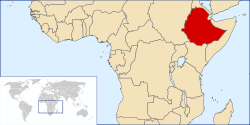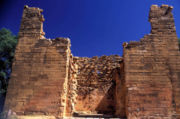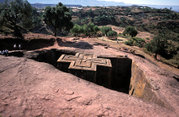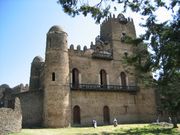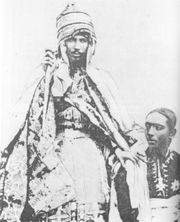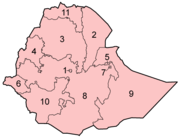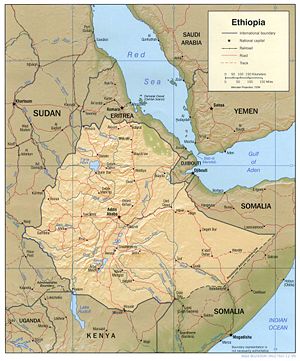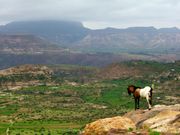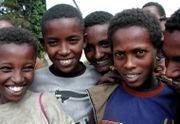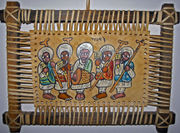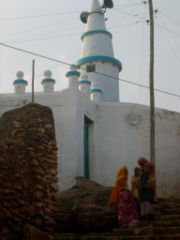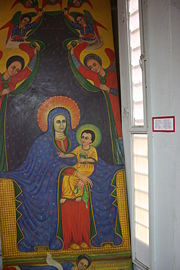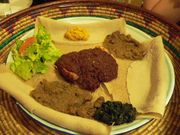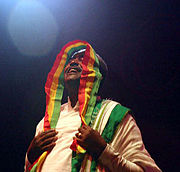Ethiopia
2008/9 Schools Wikipedia Selection. Related subjects: Africa; African Countries
Without rendering support, you may see question marks, boxes or other symbols instead of Ethiopic characters. |
| የኢትዮጵያ ፌዴራላዊ ዲሞክራሲያዊ ሪፐብሊክ ye-Ītyōṗṗyā Fēdēralāwī Dīmōkrāsīyāwī Rīpeblīk Federal Democratic Republic of Ethiopia
|
||||||
|---|---|---|---|---|---|---|
|
||||||
| Anthem: Wodefit Gesgeshi, Widd Innat Ityopp'ya "March Forward, Dear Mother Ethiopia" |
||||||
|
|
||||||
| Capital (and largest city) |
Addis Ababa |
|||||
| Official languages | Amharic | |||||
| Demonym | Ethiopian | |||||
| Government | Federal Parliamentary republic1 | |||||
| - | President | Girma Wolde-Giorgis | ||||
| - | Prime Minister | Meles Zenawi | ||||
| Establishment | 10th century BC | |||||
| - | Traditional date | c.980 BC | ||||
| - | Kingdom of Dʿmt | 8th century BC | ||||
| - | Kingdom of Aksum | 1st century BC | ||||
| Area | ||||||
| - | Total | 1,104,300 km² ( 27th) 426,371 sq mi |
||||
| - | Water (%) | 0.7 | ||||
| Population | ||||||
| - | 2006 estimate | 75,067,000 ( 16th²) | ||||
| - | 1994 census | 53,477,265 | ||||
| - | Density | 70/km² ( 123rd) 181/sq mi |
||||
| GDP ( PPP) | 2005 estimate | |||||
| - | Total | $69.099 billion ( 69th) | ||||
| - | Per capita | $823 ( 175th) | ||||
| Gini (1999–00) | 30 (medium) | |||||
| HDI (2007) | ▲ 0.406 (low) ( 169th) | |||||
| Currency | Birr ( ETB) |
|||||
| Time zone | EAT ( UTC+3) | |||||
| - | Summer ( DST) | not observed ( UTC+3) | ||||
| Internet TLD | .et | |||||
| Calling code | +251 | |||||
| 1 | According to The Economist in its Democracy Index, Ethiopia is a "hybrid regime", with a dominant-party system led by the Ethiopian People's Revolutionary Democratic Front. | |||||
| 2 | Rank based on 2005 population estimate by the United Nations. | |||||
Ethiopia (IPA: /ˌiːθiːˈoʊpiə/) ( Ge'ez: ኢትዮጵያ ʾĪtyōṗṗyā), officially the Federal Democratic Republic of Ethiopia, is a landlocked country situated in the Horn of Africa. Ethiopia is bordered by Eritrea to the north, Sudan to the west, Kenya to the south, Somalia to the east and Djibouti to the north-east.
Ethiopia is one of the oldest countries in the world and Africa's second-most populous nation. Ethiopia has yielded some of humanity's oldest traces, making the area important in the history of human evolution. Recent studies claim that the vicinity of present-day Addis Ababa was the point from which human beings migrated around the world. Ethiopian dynastic history traditionally began with the reign of Emperor Menelik I in 1000 BC. The roots of the Ethiopian state are similarly deep, dating with unbroken continuity to at least the Aksumite Empire (which adopted the name "Ethiopia" in the 4th century) and its predecessor state, D`mt (with early 1st millennium BC roots). After a period of decentralized power in the 18th and early 19th centuries known as the Zemene Mesafint ("Era of the Judges/Princes"), the country was reunited in 1855 by Kassa Hailu, who became Emperor Tewodros II, beginning Ethiopia's modern history. Ethiopia's borders underwent significant territorial expansion to its modern borders for the rest of the century, especially by Emperor Menelik II and Ras Gobena, culminating in its victory over the Italians at the Battle of Adwa in 1896 with the military leadership of Ras Makonnen, and ensuring its sovereignty and freedom from colonization. It was brutally occupied by Mussolini's Italy from 1936 to 1941, ending with its liberation by British Empire and Ethiopian Patriot forces.
Having converted during the fourth century AD, it is also the second-oldest country to become officially Christian, after Armenia. Since 1974, it has been secular and has also had a considerable Muslim community since the earliest days of Islam. Historically a relatively isolated mountain country, Ethiopia by the mid 20th century became a crossroads of global international cooperation. It became a member of the League of Nations in 1923, signed the Declaration by United Nations in 1942, and was one of the fifty-one original members of the United Nations (UN). The headquarters of United Nations Economic Commission for Africa (UNECA) is in Addis Ababa, as is the headquarters of the African Union (formerly the Organisation of African Unity), of which Ethiopia was the principal founder. There are about forty-five Ethiopian embassies and consulates around the world.
Name
It is not certain how old the name Ethiopia is; its earliest attested use is in the Iliad , where it appears twice, and in the Odyssey, where it appears three times. The earliest attested use in the region is as a Christianized name for the Kingdom of Aksum in the 4th century, in stone inscriptions of King Ezana. The Ge'ez name ʾĪtyōṗṗyā and its English cognate are thought by some recent scholars to be derived from the Greek word Αἰθιοπία Aithiopia, from Αἰθίοψ Aithiops ‘an Ethiopian’, derived in turn from Greek words meaning "of burned face". However, the Book of Aksum, a Ge'ez chronicle compiled in the 15th century, states that the name is derived from "' Ityopp'is" — a son (unmentioned in the Bible) of Cush, son of Ham who according to legend founded the city of Axum. Pliny the Elder similarly states the tradition that the nation took its name from someone named Aethiops. A third etymology, suggested by the late Ethiopian scholar and poet laureate Tsegaye Gabre-Medhin, traces the name to the "old black Egyptian [sic]" words Et (Truth or Peace) Op (high or upper) and Bia (land, country), or "land of higher peace".
In English and generally outside of Ethiopia, the country was also once historically known as Abyssinia, derived from Habesh, an early Arabic form of the Ethiosemitic name "Ḥabaśāt" (unvocalized "ḤBŚT"), modern Habesha, the native name for the country's inhabitants (while the country was called "Ityopp'ya"). In a few languages, Ethiopia is still called by names cognate with "Abyssinia," e.g., and modern Arabic Al Habeshah, meaning land of the Habesha people. The term Habesha, strictly speaking, refers only to the Amhara and Tigray-Tigrinya people who have historically dominated the country politically, and which combined comprise about 36% of Ethiopia's population. However, in contemporary Ethiopian politics, the word Habesha is often used to describe all Ethiopians and Eritreans. Abyssinia can strictly refer to just the North-Western Ethiopian provinces of Amhara and Tigray as well as central Eritrea, while it was historically used as another name for Ethiopia.
History
Early history
Human settlement in Ethiopia dates back to prehistoric times. Fossilized remains of the earliest ancestors to the human species, discovered in Ethiopia, have been assigned dates as long ago as 5.9 million years. Together with Eritrea and the southeastern part of the Red Sea coast of Sudan ( Beja lands), it is considered the most likely location of the land known to the ancient Egyptians as Punt (or "Ta Netjeru," meaning land of the Gods), whose first mention dates to the twenty-fifth century BC.
Around the eighth century BC, a kingdom known as Dʿmt was established in northern Ethiopia and Eritrea, with its capital at Yeha in northern Ethiopia. Most modern historians consider this civilization to be a native African one, although Sabaean-influenced due to the latter's hegemony of the Red Sea, while others view Dʿmt as the result of a mixture of "culturally superior" Sabaeans and indigenous peoples. However, Ge'ez, the ancient Semitic language of Ethiopia, is now thought not to have derived from Sabaean (also South Semitic). There is evidence of a Semitic-speaking presence in Ethiopia and Eritrea at least as early as 2000 BC. Sabaean influence is now thought to have been minor, limited to a few localities, and disappearing after a few decades or a century, perhaps representing a trading or military colony in some sort of symbiosis or military alliance with the Ethiopian civilization of Dʿmt or some other proto-Aksumite state.
After the fall of Dʿmt in the fourth century BC, the plateau came to be dominated by smaller successor kingdoms, until the rise of one of these kingdoms during the first century BC, the Aksumite Kingdom, ancestor of medieval and modern Ethiopia, which was able to reunite the area. They established bases on the northern highlands of the Ethiopian Plateau and from there expanded southward. The Persian religious figure Mani listed Aksum with Rome, Persia, and China as one of the four great powers of his time.
In 316 AD, a Christian philosopher from Tyre, Meropius, embarked on a voyage of exploration along the coast of Africa. He was accompanied by, among others, two Syro-Greeks, Frumentius and his brother Aedesius. The vessel was stranded on the coast, and the natives killed all the travelers except the two brothers, who were taken to the court and given positions of trust by the monarch. They both practiced the Christian faith in private, and soon converted the queen and several other members of the royal court. Upon the king's death, Frumentius was appointed regent of the realm by the queen, and instructor of her young son, Prince Ezana. A few years later, upon Ezana's coming of age, Aedesius and Frumentius left the kingdom, the former returning to Tyre where he was ordained, and the latter journeying to Alexandria. Here, he consulted Athanasius, who ordained him and appointed him Bishop of Aksum. He returned to the court and baptized the King Ezana, together with many of his subjects, and in short order Christianity was proclaimed the official state religion again. For this accomplishment, he received the title "Abba Selama" ("Father of peace").
At various times, including a fifty-year period in the sixth century, Aksum controlled most of modern-day Yemen and some of southern Saudi Arabia just across the Red Sea, as well as controlling southern Egypt, northern Sudan, northern Ethiopia, Eritrea, Djibouti, and northern Somalia.
The line of rulers descended from the Aksumite kings was broken several times: first by the Jewish (unknown/or pagan) Queen Gudit around 950 (or possibly around 850, as in Ethiopian histories). It was then interrupted by the Zagwe dynasty; it was during this dynasty that the famous rock-hewn churches of Lalibela were carved under King Lalibela, allowed by a long period of peace and stability.
Ethiopian Empire
Around 1270, the Solomonic dynasty came to control Ethiopia, claiming descent from the kings of Aksum. They called themselves Neguse Negest ("King of Kings," or Emperor), due to their direct descent from Solomon and the queen of Sheba.
Restored contact with Europe
In the early fifteenth century Ethiopia sought to make diplomatic contact with European kingdoms for the first time since Aksumite times. A letter from King Henry IV of England to the Emperor of Abyssinia survives. In 1428, the Emperor Yeshaq sent two emissaries to Alfons V of Aragon, who sent return emissaries that failed to complete the return trip. The first continuous relations with a European country began in 1508 with Portugal under Emperor Lebna Dengel, who had just inherited the throne from his father.
This proved to be an important development, for when the Empire was subjected to the attacks of the Adal General and Imam, Ahmad ibn Ibrihim al-Ghazi (called "Grañ", or "the Left-handed"), Portugal responded to Lebna Dengel's plea for help with an army of four hundred men, who helped his son Gelawdewos defeat Ahmad and re-establish his rule. However, when Emperor Susenyos converted to Roman Catholicism in 1624, years of revolt and civil unrest followed resulting in thousands of deaths. The Jesuit missionaries had offended the Orthodox faith of the local Ethiopians, and on June 25, 1632 Susenyos' son, Emperor Fasilides, declared the state religion to again be Ethiopian Orthodox Christianity, and expelled the Jesuit missionaries and other Europeans.
Zemene Mesafint
All of this contributed to Ethiopia's isolation from 1755 to 1855, called the Zemene Mesafint or "Age of Princes." The Emperors became figureheads, controlled by warlords like Ras Mikael Sehul of Tigray, and by the Oromo Yejju dynasty, which later led to 17th century Oromo rule of Gondar, changing the language of the court from Amharic to Afaan Oromo. Ethiopian isolationism ended following a British mission that concluded an alliance between the two nations; however, it was not until 1855 that Ethiopia was completely reunited and the power in the Emperor restored, beginning with the reign of Emperor Tewodros II. Upon his ascent, despite still large centrifugal forces, he began modernizing Ethiopia and recentralizing power in the Emperor, and Ethiopia began to take part in world affairs once again.
By the 1880s, Sahle Selassie, as king of Shewa, and later as Emperor Menilik II, with the help of Ras Gobena's Shewan Oromo milita, began expanding his kingdom to the South and East, expanding into areas that hadn't been held since the invasion of Ahmed Gragn, and other areas that had never been under his rule, resulting in the borders of Ethiopia of today.
European Scramble for Africa
The 1880s were marked by the Scramble for Africa and modernization in Ethiopia, when the Italians began to vie with the British for influence in bordering regions. Asseb, a port near the southern entrance of the Red Sea, was bought in March 1870 from the local Afar sultan, vassal to the Ethiopian Emperor, by an Italian company, which by 1890 led to the Italian colony of Eritrea. Conflicts between the two countries resulted in the Battle of Adwa in 1896, whereby the Ethiopians surprised the world by defeating Italy and remaining independent, under the rule of Menelik II. Italy and Ethiopia signed a provisional treaty of peace on October 26, 1896.
Selassie years
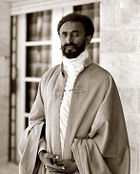
The early twentieth century was marked by the reign of Emperor Haile Selassie I, who came to power after Iyasu V was deposed. It was he who undertook the modernization of Ethiopia, from 1916, when he was made a Ras and Regent (Inderase) for Zewditu I and became the de facto ruler of the Ethiopian Empire. Following Zewditu's death he was made Emperor on 2 November 1930.
Being born from parents of the three main Ethiopian ethnicities of Oromo, Amhara and Gurage, and after having played a leading role in the formation of the African Union, Haile Selassie was known as a uniting figure both inside Ethiopia and around Africa.
The independence of Ethiopia was interrupted by the Second Italo-Abyssinian War and Italian occupation (1936–1941). Some of Ethiopia's infrastructure (roads most importantly) was built by the fascist Italian occupation troops (not by corvee) between 1937 and 1940. Following the entry of Italy into World War II, the British Empire forces together with patriot Ethiopian fighters liberated Ethiopia in the course of the East African Campaign (World War II) in 1941, which was followed by sovereignty on January 31, 1941 and British recognition of full sovereignty (i.e. without any special British privileges) with the signing of the Anglo-Ethiopian Agreement in December 1944. During 1942 and 1943 there was an Italian guerrilla war in Ethiopia. On August 26, 1942 Haile Selassie I issued a proclamation outlawing slavery.
In 1952 Haile Selassie orchestrated the federation with Eritrea which he dissolved in 1962. This annexation sparked the Eritrean War of Independence. Although Haile Selassie was seen as a national and African hero, opinion within Ethiopia turned against him due to the worldwide oil crisis of 1973, food shortages, uncertainty regarding the succession, border wars, and discontent in the middle class created through modernization.
Haile Selassie's reign came to an end in 1974, when a Soviet backed Marxist-Leninist military junta, the " Derg" led by Mengistu Haile Mariam, deposed him, and established a one-party communist state.
Communism
The ensuing regime suffered several coups, uprisings, wide-scale drought, and a massive refugee problem. In 1977, there was the Ogaden War, but Ethiopia quickly defeated Somalia with a massive influx of Soviet military hardware and a Cuban military presence coupled with East Germany and South Yemen the following year.
Hundreds of thousands were killed due to the red terror, forced deportations, or from using hunger as a weapon. In 2006, after a long trial, Mengistu was found guilty of genocide.
Recent
In 1993 a referendum was held & supervised by the UN mission UNOVER, with universal suffrage and conducted both in and outside Eritrea (among Eritrean communities in the diaspora), on whether Eritreans wanted independence or unity with Ethiopia. Over 99% of the Eritrean people voted for independence which was declared on May 24, 1993. In 1994, a constitution was adopted that led to Ethiopia's first multi-party elections in the following year. In May 1998, a border dispute with Eritrea led to the Eritrean-Ethiopian War that lasted until June 2000. This has hurt the nation's economy, but strengthened the ruling coalition. On May 15, 2005, Ethiopia held another multiparty election, which was a highly disputed one with some opposition groups claiming fraud. Though the Carter Centre appreciated the preelection conditions, it has expressed its dissatisfaction with postelection matters. The 2005 EU election observers continued to accuse the ruling party of vote rigging. Many from the international community are divided about the issue with Irish officials accusing the 2005 EU election observers of corruption for the "inaccurate leaks from the 2005 EU election monitoring body which led the opposition to wrongly believe they had been cheated of victory." In general, the opposition parties gained more than 200 parliament seats compared to the just 12 in the 2000 elections. Despite most opposition representatives joining the parliament, some leaders of the CUD party are in jail following the post-election violence. Amnesty International considers them " prisoners of conscience".
Politics
Politics of Ethiopia takes place in a framework of a federal parliamentary republic, whereby the Prime Minister is the head of government. Executive power is exercised by the government. Federal legislative power is vested in both the government and the two chambers of parliament.
On the basis of Article 78 of the 1994 Ethiopian Constitution, the Judiciary is completely independent of the executive and the legislature. The current realities of this provision are questioned in a report prepared by Freedom House (see discussion page for link).
According to The Economist in its Democracy Index, Ethiopia is a "hybrid regime" situated between a "flawed democracy" and an "authoritarian regime". It ranks 106 out of 167 countries (with the larger number being less democratic). Cambodia ranks as more democratic at 105, and Burundi as less democratic at 107, than Ethiopia.
The election of Ethiopia's 547-member constituent assembly was held in June 1994. This assembly adopted the constitution of the Federal Democratic Republic of Ethiopia in December 1994. The elections for Ethiopia's first popularly-chosen national parliament and regional legislatures were held in May and June 1995 . Most opposition parties chose to boycott these elections. There was a landslide victory for the Ethiopian People's Revolutionary Democratic Front (EPRDF). International and non-governmental observers concluded that opposition parties would have been able to participate had they chosen to do so.
The current government of Ethiopia was installed in August 1995. The first President was Negasso Gidada. The EPRDF-led government of Prime Minister Meles Zenawi promoted a policy of ethnic federalism, devolving significant powers to regional, ethnically-based authorities. Ethiopia today has nine semi-autonomous administrative regions that have the power to raise and spend their own revenues. Under the present government, some fundamental freedoms, including freedom of the press, are circumscribed. Citizens have little access to media other than the state-owned networks, and most private newspapers struggle to remain open and suffer periodic harassment from the government. At least 18 journalists who had written articles critical of the government were arrested following the 2005 elections on genocide and treason charges. The government uses press laws governing libel to intimidate journalists who are critical of its policies.
Zenawi's government was elected in 2000 in Ethiopia's first ever multiparty elections; however, the results were heavily criticized by international observers and denounced by the opposition as fraudulent. The EPRDF also won the 2005 election returning Zenawi to power. Although the opposition vote increased in the election, both the opposition and observers from the European Union and elsewhere stated that the vote did not meet international standards for fair and free elections. Ethiopian police are said to have massacred 193 protesters, mostly in the capital Addis Ababa, in the violence following the May 2005 elections in the Ethiopian police massacre. The government initiated a crackdown in the provinces as well; in Oromia state the authorities used concerns over insurgency and terrorism to use torture, imprisonment, and other repressive methods to silence critics following the election, particularly people sympathetic to the registered opposition party Oromo National Congress (ONC).
Regions, zones, and districts
Before 1996, Ethiopia was divided into 13 provinces, many derived from historical regions. Ethiopia now has a tiered government system consisting of a federal government overseeing ethnically-based regional states, zones, districts ( woredas), and neighborhoods ( kebele).
Ethiopia is divided into nine ethnically-based administrative states (kililoch, sing. kilil) and subdivided into sixty-eight zones and two chartered cities (astedader akababiwoch, sing. astedader akababi): Addis Ababa and Dire Dawa (subdivisions 1 and 5 in the map, respectively). It is further subdivided into 550 woredas and six special woredas.
The constitution assigns extensive power to regional states that can establish their own government and democracy according to the federal government's constitution. Each region has its apex regional council where members are directly elected to represent the districts and the council has legislative and executive power to direct internal affairs of the regions. Article 39 of the Ethiopian Constitution further gives every regional state the right to secede from Ethiopia. There is debate, however, as to how much of the power guaranteed in the constitution is actually given to the states. The councils implement their mandate through an executive committee and regional sectoral bureaus. Such elaborate structure of council, executive, and sectoral public institutions is replicated to the next level (woreda).
The nine regions and two chartered cities are:
|
|
Geography
At 435,071 square miles (1,127,127 km²), Ethiopia is the world's 27th-largest country (after Colombia). It is comparable in size to Bolivia, and is about two-thirds as large as the US state of Alaska.
The major portion of Ethiopia lies on the Horn of Africa, which is the eastern-most part of the African landmass. Bordering Ethiopia is Sudan to the west, Djibouti and Eritrea to the north, Somalia to the east, and Kenya to the south. Within Ethiopia is a massive highland complex of mountains and dissected plateaus divided by the Great Rift Valley, which runs generally southwest to northeast and is surrounded by lowlands, steppes, or semi-desert. The great diversity of terrain determines wide variations in climate, soils, natural vegetation, and settlement patterns.
Climate and landforms
Elevation and geographic location produce three climatic zones: the cool zone above 2,400 meters (7,900 ft) where temperatures range from near freezing to 16 ° C (32 °–61 ° F); the temperate zone at elevations of 1,500 to 2,400 meters (4,900–7,900 ft) with temperatures from 16 to 30 °C (61–86 ° F); and the hot zone below 1,500 meters (4,900 ft) with both tropical and arid conditions and daytime temperatures ranging from 27 to 50 °C (81–122 ° F). The topography of Ethiopia ranges from several very high mountain ranges (the Semien Mountains and the Bale Mountains), to one of the lowest areas of land in Africa, the Danakil depression.
The normal rainy season is from mid-June to mid-September (longer in the southern highlands) preceded by intermittent showers from February or March; the remainder of the year is generally dry.
Ethiopia is an ecologically diverse country, ranging from the deserts along the eastern border to the tropical forests in the south to extensive Afromontane in the northern and southwestern parts. Lake Tana in the north is the source of the Blue Nile. It also has a large number of endemic species, notably the Gelada Baboon, the Walia Ibex and the Ethiopian wolf (or Simien fox). The wide range of altitude has given the country a variety of ecologically distinct areas, this has helped to encourage the evolution of endemic species in ecological isolation.
Endangered Species
Historically, throughout the African continent, wildlife populations have been rapidly declining due to logging, civil wars, hunting, pollution, poaching, and other human interference. A 17-year long civil war along with severe drought, negatively impacted Ethiopia’s environmental conditions leading to even greater habitat degradation. Habitat destruction is a factor that leads to endangerment. When changes to a habitat occur rapidly, it doesn’t allow animals time to adjust. Human impact threatens many species, with greater threats expected as a result of climate change induced by greenhouse gas emissions.
Ethiopia has a large number of species listed as critically endangered, endangered and vulnerable to global extinction. To assess the current situation in Ethiopia, it is critical that the endangered species in this region are identified. The endangered species in Ethiopia can be broken down into three categories; Critically endangered, Endangered and Vulnerable.
| Critically Endangered | Endangered | Vulnerable |
|---|---|---|
| Bilen Gerbil | Grevy’s Zebra | African Elephant |
| Black Rhinoceros | Mountain Nyala | Ammodile |
| Ethiopian Wolf | Nubian Ibex | Bailey’s Shrew |
| Guramba Shrew | Wild Dog | Bale Shrew |
| Harenna Shrew | Beira Antelope | |
| MacMillan’s Shrew | Cheetah | |
| Walia Ibex | Dibatag | |
| Dorcas Gazelle | ||
| Glass’s Shrew | ||
| Large-eared Free-tailed Bat | ||
| Lesser Horseshoe Bat | ||
| Lion | ||
| Moorland Shrew | ||
| Morris’s Bat | ||
| Mouse-tailed Bat Species | ||
| Natal Free-tailed Bat | ||
| Nikolaus’s Mouse | ||
| Patrizi’s Trident Leaf-nosed Bat | ||
| Red-fronted Gazelle | ||
| Rupp’s Mouse | ||
| Scott’s Mouse-eared Bat | ||
| Soemmerring’s Gazelle | ||
| Speke’s Gazelle | ||
| Spotted-necked Otter | ||
| Stripe-backed Mouse |
There are 31 endemic species, meaning that a species occurs naturally only in a certain area, in this case Ethiopia. The Ethiopian Wolf is perhaps the most researched of all the endangered species within Ethiopia.
The Ethiopian Wolf
Ethiopian wolves are decreasing rapidly in population. Fewer than 500 remain today due to the increased pressure from agriculture, high altitude grazing, hybridization with domestic dogs, direct persecution, and diseases such as rabies. The EWCP (Ethiopian Wolf Conservation Project) actively works on protecting this species. Scientists working with this project have found that this species has some resistance to the effects of small population sizes and some resilience to fragmentation. A 2003 study on the Ethiopian wolf resulted in the conclusion that the key to its survival resides in securing its habitat and isolating its population from the impact of people, livestock and domestic dogs. The interaction between humans and Ethiopian wolves have become increasingly threatening to their conservation as these negative interactions increase as human density increases. Human interactions include poisoning, persecution in reprisal for livestock losses, and road kills. Mountainous areas are critical for Ethiopian wolves survival to provide a healthy habitat. Protecting this unique creature entails securing protected status for conservation areas where ecological processes are preserved in an ecosystem, and addressing and counteracting direct threats to survival (human persecution, fragmented populations and coexistence with domestic dogs.) Biologists also recommend the goal of preserving a minimum of 90% of the existing genetic diversity of the species for 100 years, which may require establishing a Nucleus I captive breeding population (preferably in Ethiopia). These aspirations are being pursued by a group called the Ethiopian Wolf Recovery Programme (EWRP).
Outreach Several conservation programs are in effect to help endangered species in Ethiopia. A group was created in 1966 called The Ethiopian Wildlife and Natural History Society, which focuses on studying and promoting the natural environments of Ethiopia along with spreading the knowledge they acquire, and supporting legislation to protect environmental resources.
There are multiple conservation organizations one can access online to make donations, one which connects directly to the Ethiopian Wolf. Funding supports the World Wildlife Fund’s global conservation efforts. The majority of the funds received (83%) goes towards conservation activities, while only 6% goes towards finance and administration. The remaining 11% of funds are allocated for fundraising, which is much needed. The WWF Chairman of the Board, Bruce Babbitt holds this organization accountable for the best practices in accountability, governance and transparency throughout all tiers within the organization.
A critical way to help threatened animals survive would be to protect their habitat permanently through national parks, wilderness areas and nature reserves. By protecting the places where animals live, human interference is limited. Protecting farms, and any place along roadsides that harbour animals helps encourage protection.
Deforestation
Deforestation is a major concern for Ethiopia as studies suggest loss of forest contributes to soil erosion, loss of nutrients in the soil, loss of animal habitats and reduction in biodiversity. At the beginning of the Twentieth century around 420,000 km² or 35% of Ethiopia’s land was covered by trees but recent research indicates that forest cover is now approximately 11.9% of the area. Ethiopia is one of the seven fundamental and independent centers of origin of cultivated plants of the world.
Ethiopia loses an estimated 1,410 km² of natural forests each year. Between 1990 and 2005 the country lost approximately 21,000 km².
Current government programs to control deforestation consist of education, promoting reforestation programs and providing alternate raw material to timber. In rural areas the government also provides non-timber fuel sources and access to non-forested land to promote agriculture without destroying forest habitat.
Organizations such as SOS and Farm Africa are working with the federal government and local governments to create a system of forest management. Working with a grant of approximately 2.3 million Euros the Ethiopian government recently began training people on reducing erosion and using proper irrigation techniques that do not contribute to deforestation. This project is assisting more than 80 communities.
Urbanization
Population growth, migration, and urbanization are all straining both governments and ecosystems’ capacity to provide people basic services. Urbanization has steadily been increasing in Ethiopia, with two periods of significantly rapid growth. First, in 1936-1941 during the Italian occupation of Mussolini’s fascist regime, and from 1967-1975 when the populations of urban centers tripled. In 1936, Italy annexed Ethiopia, building infrastructure to connect major cities, and a dam providing power and water. This along with the influx of Italians and laborers was the major cause of rapid growth during this period. The second period of growth was from 1967-1975 when rural populations migrated to urban centers seeking work and better living conditions. This pattern slowed after to the 1975 Land Reform program instituted by the government provided incentives for people to stay in rural areas. As people moved from rural areas to the cities, there were fewer people to grow food for the population. The Land Reform Act was meant to increase agriculture since food production was not keeping up with population growth over the period of 1970-1983. This program proliferated the formation of peasant associations, large villages based on agriculture. The act did lead to an increase in food production, although there is debate over the cause; it may be related to weather conditions more than the reform act. Urban populations have continued to grow with an 8.1% increase from 1975-2000.
Rural Vs. Urban Life Migration to urban areas is usually motivated by the hope of better living conditions. In peasant associations daily life is a struggle to survive. Only 45% of rural households in Ethiopia consume the World Health Organization’s minimum standard of food per day, (2,200 kilocalories), with 42% of children under 5 years old being underweight. Most poor families (75%) share their sleeping quarters with livestock, and 40% of children sleep on the floor, where night time temperatures average 5 degrees Celsius in the cold season. The average family size is six or seven, living in a 30 square meter mud and thatch hut, with less than two hectares of land to cultivate. These living conditions are deplorable, but are the daily lives of peasant associations.
The peasant associations face a cycle of poverty. Since the land holdings are so small, farmers cannot allow the land to lie fallow, which reduces soil fertility. This land degradation reduces the production of fodder for livestock, which causes low amounts of milk production. Since the community burns livestock manure as fuel, rather than plowing the nutrients back into the land, the crop production is reduced. The low productivity of agriculture leads to inadequate incomes for farmers, hunger, malnutrition and disease. These unhealthy farmers have a hard time working the land and the productivity drops further.
Although conditions are drastically better in cities, all of Ethiopia suffers from poverty, and poor sanitation. In the capital city of Addis Ababa, 85% of the population lives in slums. Although there are some wealthy neighborhoods with mansions, most people make their houses using whatever materials are available, with walls made of mud or wood. Only 12% of homes have cement tiles or floors. Sanitation is the most pressing need in the city, with most of the population lacking access to waste treatment facilities. This contributes to the spread of illness through unhealthy water.
Despite the living conditions in the cities, the people of Addis Ababa are much better off than people living in the peasant associations due to their educational opportunities. Unlike rural children, 69% of urban children are enrolled in primary school, and 35% of those eligible for secondary school attend. Addis Ababa has its own university as well as many other secondary schools. The literacy rate is 82%.
Health is also much greater in the cities. Birth rates, infant mortality rates, and death rates are lower in the city than in rural areas, due to better access to education and hospitals. Life expectancy is higher at 53, compared to 48 in rural areas. Despite sanitation being a problem, use of improved water sources is also greater; 81% in cities compared to 11% in rural areas. This encourages more people to migrate to the cities in hopes of better living conditions.
The continued urbanization and migration poses a threat to environmental sustainability in Ethiopia. As more migration occurs, there will be decreased food production to sustain the population. Rather than fixing the problems of degraded land and water resources, people move to cities in hopes of a better life. If nothing is done about the problem, the capacity to grow food will decrease as populations continue to increase, while poverty and health conditions get worse.
This is a problem many NGOs (Non-Government Organizations) are working on fixing. But there is clear evidence that most are far apart, less coordinated, and working in isolation, with no effective mechanisms for them to relate with other NGOs. This is why a consortium is required to solve the problem. The good news is that the Sub-Saharan Africa NGO Consortium is already coordinating efforts among NGOs in Uganda, Kenya, Tanzania, Zambia, South Africa, Zimbabwe, Ethiopia, Sudan, Cameroon, Democratic Republic of Congo, Senegal, Ivory Coast, Mali, Ghana, and Nigeria. By sharing information, techniques, and resources, NGOs are better equipped to help the rural farmers of Ethiopia.
Economy
Ethiopia has remained one of the poorest countries in the world. Recently, Ethiopia has showed a fast growing annual GDP and it is the fastest growing non-oil dependent African nation in 2007. Since 1991, there have been attempts to improve the economy. This is reflected in the ten percent economic growth registered for the past six consecutive years. Yet, a daunting task of maintaining this growth and reducing urban poverty remains to be done.
Provision of telecommunications services is left to a publicly owned monopoly. It is the view of the current government that maintaining public ownership in this vital sector is essential to ensure that telecommunication infrastructures and services are extended to the rural Ethiopia, which would not be attractive to private enterprises.
There are some sectors which are reserved to Ethiopians only. The financial sector is one of them. There are now more than seven private banks in the country but none of them are owned by foreigners.
The Ethiopian constitution defines the right to own land as belonging only to "the state and the people", but citizens may only lease land (up to 99 years), and are unable to mortgage or sell. Renting of land for a maximum of twenty years is allowed and this is expected to ensure that land goes to the most productive user.
Agriculture accounts for almost 41 percent of the gross domestic product (GDP), 80 percent of exports, and 80 percent of the labour force. Many other economic activities depend on agriculture, including marketing, processing, and export of agricultural products. Production is overwhelmingly by small-scale farmers and enterprises and a large part of commodity exports are provided by the small agricultural cash-crop sector. Principal crops include coffee, pulses (e.g., beans), oilseeds, cereals, potatoes, sugarcane, and vegetables. Recently, Ethiopia has had a fast growing annual GDP and it was the fastest growing non-oil dependent African nation in 2007. Exports are almost entirely agricultural commodities, and coffee is the largest foreign exchange earner. Ethiopia is Africa's second biggest maize producer. Ethiopia's livestock population is believed to be the largest in Africa, and as of 1987 accounted for about 15 percent of the GDP. Despite recent improvements, the rapidly exploding population means that Ethiopia remains one of the poorest nations in the world. According to a recent UN report the GNP per capita of Ethiopia has reached $160.The same report indicated that the life expectancy had improved substantially in recent years. The life expectancy of men is reported to be 52 and women 54 years.
Exports
Ethiopia was the original source of the coffee bean, and coffee beans are the country's largest export commodity.
Ethiopia is also the 10th largest producer of livestock in the world. Other main export commodities are khat, gold, leather products, and oilseeds. Recent development of the floriculture sector means Ethiopia is poised to become one of the top flower and plant exporters in the world.
With the private sector growing slowly, designer leather products like bags are becoming a big export business, with Taytu becoming the first luxury designer label in the country. Additional small-scale export products include cereals, pulses, cotton, sugarcane, potatoes and hides. With the construction of various new dams and growing hydroelectric power projects around the country, it has also begun exporting electric power to its neighbors. However, coffee remains its most important export product and with new trademark deals around the world, including recent deals with Starbucks, the country plans to increase its revenue from coffee. Most regard Ethiopia's large water resources and potential as its "white oil" and its coffee resources as "black gold".
The country also has large mineral resources and oil potential in some the less inhabited regions; however, political instability in those regions has harmed progress. Ethiopian geologists were implicated in a major gold swindle in 2008. Four chemists and geologists from the Ethiopian Geological Survey were arrested in connection with a fake gold scandal, following complaints from buyers in South Africa. Gold bars from the National Bank of Ethiopia were found to be gilded metal by police, costing the state around US$17 million, according to the Science and Development Network website.
Demographics
Ethiopia's population has grown from 33.5 million in 1983 to 75.1 million in 2006. The country's population is highly diverse. Most of its people speak a Semitic or Cushitic language. The Oromo, Amhara, and Tigray make up more than three-quarters of the population, but there are more than 80 different ethnic groups within Ethiopia. Some of these have as few as 10,000 members.
Ethiopians and Eritreans, especially Semitic-speaking ones, collectively refer to themselves as Habesha or Abesha, though others reject these names on the basis that they refer only to certain ethnicities. The Arabic form of this term (Al-Habasha) is the etymological basis of "Abyssinia," the former name of Ethiopia in English and other European languages.
According to the Ethiopian national census of 1994, the Oromo are the largest ethnic group in Ethiopia at 32.1%. The Amhara represent 30.2%, while the Tigray people are 6.2% of the population. Other ethnic groups are as follows: Somali 6%, Gurage 4.3%, Sidama 3.4%, Wolayta 2%, Afar 2%, Hadiya 2%, Gamo 1%.
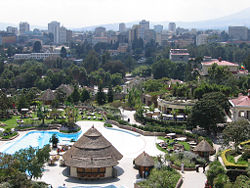
There are 1.2 million Ethiopians in the US as part of the Ethiopian diaspora.
In 2007, Ethiopia hosted a population of refugees and asylum seekers numbering approximately 201,700. The majority of this population came from Somalia (approximately 111,600 individuals), Sudan (55,400) and Eritrea (23,900). The Ethiopian government required nearly all refugees to live in refugee camps.
Religion
According to the most recent 1994 National Census, Christians make up 61.6% of the country's population, Muslims 32.8%, and practitioners of traditional faiths 5.6%. This agrees with the updated CIA World Factbook, Christianity is the most widely practiced religion in Ethiopia. but the US State department has contradictory figures, putting Islam as being about equal or a slight majority, so a review of the figures might be needed (Sunnis Islam=45%-50%, Orthodoxy= 40%, Protestant 5% and the rest traditional). Orthodox Christianity has a dominant presence in central and northern Ethiopia, while both Orthodox & Protestant Christianity has large representations in the South and Western Ethiopia. A small ancient group of Jews, the Beta Israel, live in northwestern Ethiopia, though most have emigrated to Israel in the last decades of the twentieth century as part of the rescue missions undertaken by the Israeli government, Operation Moses and Operation Solomon. Some Israeli and Jewish scholars consider these Ethiopian Jews as the historical " Lost Tribe of Israel". Sometimes Christianity in Africa is thought of as a European import that arrived with colonialism, but this is not the case with Ethiopia. The Kingdom of Aksum was one of the first nations to officially adopt Christianity, when St. Frumentius of Tyre, called Fremnatos or Abba Selama ("Father of Peace") in Ethiopia, converted King Ezana during the fourth century AD. Many believe that the Gospel had entered Ethiopia even earlier, with the royal official described as being baptised by Philip the Evangelist in chapter eight of the Acts of the Apostles. (Acts 8:26-39) Today, the Ethiopian Orthodox Tewahedo Church, part of Oriental Orthodoxy, is by far the largest denomination, though a number of Protestant ( Pentay) churches and the Ethiopian Orthodox Tehadeso Church have recently gained ground. Since the eighteenth century there has existed a relatively small Uniate Ethiopian Catholic Church in full communion with Rome, with adherents making up less than 1% of the total population.
The name "Ethiopia" (Hebrew Kush) is mentioned in the Bible numerous times (thirty-seven times in the King James version). Abyssinia is also mentioned in the Qur'an and Hadith. While many Ethiopians claim that the Bible references of Kush apply to their own ancient civilization, pointing out that the Gihon river, a name for the Nile, is said to flow through the land, most non-Ethiopian scholars believe that the use of the term referred to the Kingdom of Kush in particular or Africa outside of Egypt in general. Some have argued that biblical Kush was a large part of land that included Northern Ethiopia, Eritrea and most of present day Sudan. The capital cities of biblical Kush were in Northern Sudan.
Islam in Ethiopia dates back to the founding of the religion; in 615, when a group of Muslims were counseled by Muhammad to escape persecution in Mecca and travel to Ethiopia, which was ruled by Ashama ibn Abjar, a pious Christian king. Moreover, Bilal, the first muezzin, the person chosen to call the faithful to prayer, and one of the foremost companions of Muhammad, was from Ethiopia.
There are numerous indigenous African religions in Ethiopia, mainly located in the far southwest and western borderlands. In general, most of the (largely members of the non-Chalcedonian Ethiopian Orthodox Tewahedo Church) Christians generally live in the highlands, while Muslims and adherents of traditional African religions tend to inhabit more lowland regions in the east and south of the country.
Ethiopia is also the spiritual homeland of the Rastafari movement, whose adherents believe Ethiopia is Zion. The Rastafari view Emperor Haile Selassie I as Jesus, the human incarnation of God, a view apparently not shared by Haile Selassie I himself, who was staunchly Ethiopian Orthodox Christian. The concept of Zion is also prevalent among Ethiopian Orthodox Christians, though it represents a separate and complex concept, referring figuratively to St. Mary, but also to Ethiopia as a bastion of Christianity surrounded by Muslims and other religions, much like Mount Zion in the Bible. It is also used to refer to Axum, the ancient capital and religious centre of Ethiopian Orthodox Christians, or to its primary church, called Church of Our Lady Mary of Zion. The Bahá'í Faith has been established in Ethiopia since the 1950s, and today is concentrated primarily in Addis Ababa, but also in the suburbs of Yeka, Kirkos and Nefas Silk Lafto.
Health
According to the head of the World Bank's Global HIV/AIDS Program, Ethiopia has only 1 medical doctor per 100,000 people. However, the World Health Organization in its 2006 World Health Report gives a figure of 1936 physicians (for 2003), which comes to about 2.6 per 100,000. Globalization is said to affect the country, with many educated professionals leaving Ethiopia for a better economic opportunity in the West.
Ethiopia's main health problems are said to be communicable diseases caused by poor sanitation and malnutrition. These problems are exacerbated by the shortage of trained manpower and health facilities.
There are 119 hospitals (12 in Addis Ababa alone) and 412 health centers in Ethiopia.
Ethiopia has an incredibly low life expectancy at birth with the current average age being 45 years old. In America the average life expectancy is over three decades longer at the age of 77. In addition to the life expectancy rate being so low, there is also a very high infant mortality rate with over 10 percent of babies dying after or shortly after birth. Currently Ethiopia only has 3 doctors per 100,000 people. These numbers are dangerously low compared to America, which has 550 available for every one hundred thousand Americans. Currently Ethiopia, as a whole is fighting a losing battle against the AIDS epidemic.
The low proportion of doctors with western medical expertise leaves the door wide open for potentially less reliable traditional healers that use home-based therapies to heal common ailments. High rates of unemployment leave many Ethiopian citizens unable to support their families. In Ethiopia an increasing number of “false healers” using home based medicines have grown with the rising population. The differences between real and false healers are almost impossible to distinguish. However, only about ten percent of practicing healers are true Ethiopian healers. Much of the false practice can be attributed to commercialization of medicine and the high demand for healing. Both men and women are known to practice medicine from their homes. It is most commonly the men that dispense herbal medicine similar to an out of home pharmacy.
Ethiopian healers are more commonly known as traditional medical practitioners. Before the onset of Christian missionaries and westernized medicine, traditional medicine was the only form of treatment available. Traditional healers extract healing ingredients from wild plants, animals and rare minerals. Among the leading number of disease that leads to death include aids, malaria, tuberculosis and dysentery. Largely because of the costs, traditional medicine continues to be the most common form of medicine practiced. Many Ethiopians are unemployed which makes it difficult to pay for most medicinal treatments. Ethiopian medicine is heavily reliant on magical and supernatural beliefs that have little or no relation to the actual disease itself. Many physical ailments are believed to be caused by the spiritual realm which is the reason healers are most likely to integrate spiritual and magical healing techniques. Traditional medicinal practice is strongly related to the rich cultural beliefs of Ethiopia, which explains the emphasis of its use.
In Ethiopian culture there are two main theories of the cause of disease. The first is attributed to God or other supernatural forces, while the other is attributed to external factors such as unclean drinking water and unsanitary food. Most genetic diseases or deaths are viewed as the will of God. Miscarriages are thought to be the result of demonic spirits.
One medical practice that is commonly practiced irrespective of religion or economic status is female genital mutilation. Nearly four out of five Ethiopian women are circumcised. There are three levels of circumcision that involve different degrees of cutting the clitoris and vaginal area. Many of these practices are done with an unsanitary blade with little or no anesthetics. It can result in heavy bleeding, high pain, and sometimes death.
It was not until Christian missionaries traveled to Ethiopia bringing new religious beliefs and education that westernized medicine was infused into Ethiopian medicine. Today there are three medical schools in Ethiopia that began training students in 1965 two of which are linked to Addis Ababa University. There is only one psychiatric facility treatment in the whole country because Ethiopian culture is resistant to psychiatric treatment. Although there have been huge leaps and bounds in medical technology there is still a large problem in the distribution of medicine and doctors in Ethiopia.
Education
Education in Ethiopia has been dominated by the Orthodox Church for many centuries until secular education was adopted in the early 1900s. The elites, mostly Christians and central ethnic Amhara population, had the most privilege until 1974, when the government tried to reach the rural areas. In fact, until right now, it is only the elite Christians who have better chance to higher education. Languages other than Amharic are supressed. Oromo, for example wasn't allowed in the educational institutions. The current system follows very similar school expansion schemes to the rural areas as the previous 1980s system with an addition of deeper regionalisation giving rural education in their own languages starting at the elementary level and with more budget allocated to the Education Sector. The sequence of general education in Ethiopia is six years of primary school, four years of lower secondary school and two years of higher secondary school.
Cuisine
The best known Ethiopian cuisine consists of various vegetable or meat side dishes and entrees, usually a wat, or thick stew, served atop injera, a large sourdough flatbread. One does not eat with utensils, but instead uses injera to scoop up the entrees and side dishes. Tihlo prepared from roasted barley flour is very popular in Amhara, Agame, and Awlaelo (Tigrai). Traditional Ethiopian cuisine employs no pork or shellfish of any kind, as they are forbidden in the Islamic, Jewish, and Ethiopian Orthodox Christian faiths. It is also very common to eat from the same big dish in the centre of the table with a group of people.
Music
The Music of Ethiopia is extremely diverse, with each of the country's 80 ethnic groups being associated with unique sounds. Ethiopian music uses a unique modal system that is pentatonic, with characteristically long intervals between some notes. Influences include ancient Christian elements and Muslim and folk music from elsewhere in the Horn of Africa, especially Sudan and Somalia. Popular musicians include teddy Afro, Tilahun Gessesse, Aster Aweke, Hamelmal Abate, Tewodros Tadesse, Ephrem Tamiru, Muluken Melesse, Bizunesh Bekele, Mahmoud Ahmed, Tadesse Alemu, Alemayehu Eshete, Neway Debebe, Asnaketch Worku, Ali Birra, Gigi, Dawit (Messay) Mellesse, and Mulatu Astatke.
Sports
Ethiopia has some of the best middle-distance and long-distance runners in the world. Kenya and Morocco are often its opponents in World Championships and Olympic middle and long-distance events. As of March 2006, two Ethiopians dominate the long-distance running scene, mainly: Haile Gebreselassie (World champion and Olympic champion) who has set over twenty new world records and currently holds the 20 km, half-marathon, 25 km, and marathon world record, and Kenenisa Bekele (World champion, World cross country champion, and Olympic champion), who holds the 5,000 m and 10,000 m world records. Ethiopia has also had various successful sweeps by taking all three medals in various world races including during the Olympics. The last few years Ethiopian women runners have joined the men in dominating athletics, particularly the multi-gold medalists Meseret Defar and Tirunesh Dibaba. Ethiopia has added more events to the list of its preeminence in athletics, including the steeplechase which Legese Lamiso recently took the top honours.
Ethiopian distance-runners include Derartu Tulu, Abebe Bikila, Mamo Wolde, Miruts Yifter, Addis Abebe, Gebregziabher Gebremariam, Belayneh Densamo, Werknesh Kidane, Tirunesh Dibaba, Meseret Defar, Million Wolde, Assefa Mezgebu, etc. Derartu Tulu was the first woman from Africa to win an Olympic gold medal, doing so over 10,000 metres at Barcelona. Abebe Bikila, the first Olympic champion Θ representing an African nation, won the Olympic marathon in 1960 and 1964, setting world records both times. He is well-known to this day for winning the 1960 marathon in Rome while running barefoot. Miruts Yifter, the first in a tradition of Ethiopians known for their brilliant finishing speed, won gold at 5,000 and 10,000 metres at the Moscow Olympics. He is the last man to achieve this feat.
Archaeology
Ethiopia offers a greater richness in archaeological finds and historical buildings than any other country in Sub-Saharan Africa (including Sudan). In April 2005 , the Obelisk of Axum, one of Ethiopia's religious and historical treasures, was returned to Ethiopia by Italy. Under the orders of dictator Benito Mussolini, Italian troops seized the obelisk in 1937 and took it to Rome. Italy agreed to return the obelisk in 1947 in a UN agreement, and it was finally returned in 2005 . As of January 2007 the obelisk has not been erected in Ethiopia. The monument was returned to Ethiopia in three or four large segments to facilitate easier transport. The pieces are so large that the Ethiopian government has been unable to erect it or even devise a way it could feasibly be done. The original site of the obelisk is an unexcavated area that would be damaged by heavy machinery, if that were determined to be an appropriate method of erection. There have been plenty of significant discoveries including the oldest known, complete fossilized human skeleton, Lucy. Other discoveries are still being made. Recently, archeologists uncovered the ruins of the legendary ancient Islamic kingdom of Shoa, that included evidence of a large urban settlement as well as a large mosque.
Peoples and Languages
Nations, Nationalities and Peoples
|
|
|
|
|
Languages
Ethiopia has eighty-four indigenous languages. Some of these are:
|
|
|
|
|
English is the most widely spoken foreign language and is the medium of instruction in secondary schools. Amharic was the language of primary school instruction, but has been replaced in many areas by local languages such as Oromifa and Tigrinya. Ethiopia has its own alphabet, called Ge'ez or Ethiopic (ግዕዝ), and calendar.


